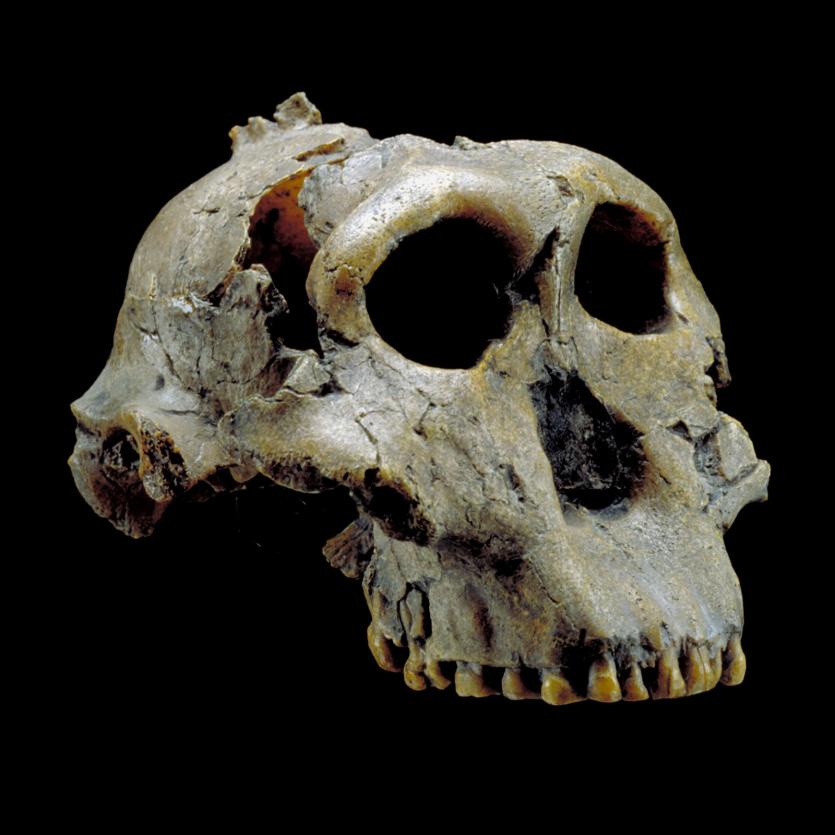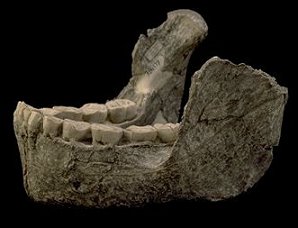OH 5
This cranium was found by Mary Leakey1 in July of 1959 in Olduvai Gorge, Tanzania. Due to its historical significance as one of the first Australopiths found by the Leakey’s it has a sort of iconic place in human origins research. Heck, they apparently even sell Zinj keychains.
When first announced, it was placed in the species Zinjanthropus boisei, though nowadays it is often called either Australopithecus boisei or Paranthropus boisei2. While the genus Zinjanthropus isn’t used, many still refer to it as “Zinj” or nutcracker man.

To see a 360 view check here
The skull dates to ~1.75 mya. As you can see in the above photo this is a fairly big skull. Anthropologists divide the australopith lineage into two main groups: the gracile ones (such as .A africanus & A. afarensis) and the robust ones (such as A. robustus & A. boisei). Zinj fits in the later category. The most striking aspect is its cheekbones, which extend sideway out from the face, what we often call “flaring zygomatics.” It also has a prominent sagittal crest, the ridge of bone down the midline of the skull where some of the chewing muscles attach. It also has small front teeth relative to their large, thickly enamled back teeth. They may have had biggest & flattest cheek teeth of any known hominin. All of these are signs of a feeding adaptation for tough foods. There is also a lot of post-orbital constriction behind the eye sockets.
Sadly, there is no mandible associated with this fossil but the Peninj 1 mandible from Tanzania might make a good analog…

Recent work on tooth microwear from A. boisei samples suggests that members of this genus did not eat hard or tough foods in the days before they die. Microwear on the teeth reflects what an individual did eat, rather than what they could have eaten, and can be used to discuss the diet of a extinct species. As the microwear patterns change often, it seems to show the foods eaten a few days before the animal died. One possibility is that A. boisei diet was similar to that of gorillas which eat soft, energy rich foods most of the time but “fall back” on more difficult to digest foods during lean times. Thus, Zinj would have developed the ability to specialize for the crunch times when it need to eat these hard foods, but most of the time wasn’t relying on them.
Originally, Louis Leakey argued that Zinj’s species was responsible for making the Oldowan stone tools. Later, after the discovery of H. habilis at the same site, he thought that Homo made the tools. But honestly I think it is not certain that Zinj didn’t make the tools. With the A. garhi finds, the Lomekwian, and other data piling up, it might be time to rethink their behavior.
Fun fact: The species name Boisei comes from Charles Boise, a mining engineer & diamond consultant who funded Leakey’s dig. If anyone wants to fund me I totally name a hominin after them
Also, Zinj would be an excellent name for a dog (If I ever get a dog I want to name them Achilles, but Zinj is a close second)3
There really should be a full-length documentay about her life. I mean, her life was fascinating↩︎
One point of current contention is the genus name: some use Australopithecus and other prefer Paranthropus. In general, the debate centers around if you think all of the robust australopiths from East and South Africa are more closely related to each other (are a monophlyum) than they are to any of the gracile species. If the robust australopiths are monophyletic, then using the genus Paranthropus demonstrates their closeness. There is more to it than this, though, and the answer is far from clear.↩︎
Why Achilles? Because then when I want the dog to come to me I can say Achilles heel…It will be hilarious every time!↩︎